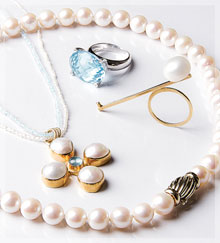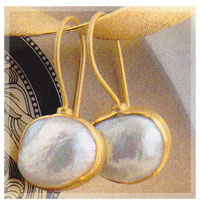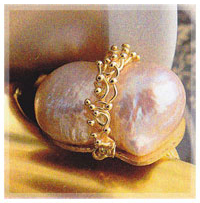
Μαργαριτάρια
ΜΑΡΓΑΡΙΤΑΡΙΑ ΤΟ ΘΑΥΜΑ ΤΗΣ ΦΥΣΗΣ

Τα μαργαριτάρια είναι γνωστά από την αρχαιότητα, έχουν μαγέψει στο πέρασμα τους όλες τις γυναίκες! Είναι το μοναδικό κλασικό κόσμημα από γενιά σε γενιά, εδώ και 3000 χρόνια.
Τα νεοελληνικά κοσμήματα διακρίνονται για την ποιότητα και την ποικιλία των σχεδίων τους. Με επιρροές από την αρχαία Ελλάδα, τη Βυζαντινή και την κλασική περίοδο, οι Έλληνες τεχνίτες κατασκευάζουν κοσμήματα με πολύτιμες πέτρες, χρησιμοποιώντας τον χρυσό Κ14 και Κ18 με κεντρικό σημείο τα μαργαριτάρια στη φυσική τους μορφή, τρυπημένα ή επεξεργασμένα.
Τα κοσμήματα της τελευταίας δεκαετίας είναι μοντέρνα, πρωτοποριακά, ανάλαφρα, κατάλληλα να φορεθούν σε κάποια επίσημη στιγμή ή και κατά τη διάρκεια όλης της ημέρας.
Κολιέ, σκουλαρίκια, δαχτυλίδια, μοτίφ, βραχιόλια από λευκόχρυσο και χρυσό δεμένα με μοναδικά μαργαριτάρια, πολύτιμες πέτρες και μπριγιάν.
"Τα μαργαριτάρια είναι γνωστά από την αρχαιότητα και είναι το μοναδικό κλασικό κόσμημα από γενιά σε γενιά, εδώ και 3000 χρόνια.
ΦΥΣΙΚΑ ΜΑΡΓΑΡΙΤΑΡΙΑ
Φυσικά μαργαριτάρια είναι εκείνα που αναπτύσσονται με φυσικές διαδικασίες σε γόνιμες υποθαλάσσιες περιοχές και είναι αποτέλεσμα μηχανισμού άμυνας του οργανισμού των μαλακών σ’ έναν άγνωστο εισβολέα (κόκκος άμμου, ένα σκουληκάκι κτλ.)
ΚΑΛΛΙΕΡΓΗΜΕΝΑ ΜΑΡΓΑΡΙΤΑΡΙΑ
Καλλιεργημένα είναι εκείνα που αναπτύσσονται με φυσικές διαδικασίες, αλλά με ανθρώπινη παρέμβαση. Σε περιοχές εύφορες οπού καλλιεργούνται μαργαργαριτοφόρα μύδια ή στρείδια ο καλλιεργητής τοποθετεί ένα ξένο σώμα (π.χ. μια μικρή μπίλια από μάργαρο) μέσα στη σάρκα, προκαλώντας έτσι τον οργανισμό να βάλει σε λειτουργία τον μηχανισμό άμυνας προς του «εισβολέα». Εκκρίνεται λοιπόν, μια ουσία, το μάργαρο, η οποία περιβάλλει το ξένο σώμα για να το απομονώσει, αρχίζοντας τη δημιουργία του μαργαριταριού.
Από εκεί και πέρα, είναι θέμα χρόνου για την ανάπτυξη του μαργαριταριού. Όσο περισσότερο χρόνο μείνει το όστρακο στο βυθό τόσο περισσότερες επιστρώσεις από μάργαρο καλύπτει τη μικρή μπίλια και το μαργαριτάρι γίνεται μεγαλύτερο. Ο αριθμός των επιστρώσεων και η ποιότητα τους είναι δυο από τους παράγοντες που προσδιορίζουν την ποιότητα των μαργαριταριών. Από τα παραπάνω καταλαβαίνουμε ότι μαργαριτάρια από φυσικά (άγρια) στρείδια ή μύδια δεν βρίσκονται στην αγορά εδώ και δεκάδες χρόνια. Τα καλλιεργημένα κατακλύζουν την αγορά και είναι εφάμιλλα ή και καλύτερης ποιότητας από τα φυσικά.
ΧΡΩΜΑΤΑ
Το χρώμα τους είναι άσπρο με διαφορετικές έγχρωμες αποχρώσεις, ασημί, ροζ, σομόν, γκρι, πράσινο, μωβ, μπλε, μαύρο μερικές φορές με ιριδίζοντα χρώματα.

ΠΗΓΗ ΠΑΡΑΓΩΓΗΣ
Πηγή παραγωγής είναι τα μαλάκια γλυκών και αλμυρών νερών, κυρίως στρείδια. Φυσικά μαργαριτάρια προέρχονται από την Σρι Λάνκα, Νότια Ινδία, τη θάλασσα της Αραβίας και την Ερυθρά θάλασσα. Μαργαριτάρια υπάρχουν επίσης στην Ταϊτή, Ιαπωνία, Κίνα, Μεξικό, Παναμά και Καλιφόρνια.
ΠΟΙΚΙΛΙΕΣ ΚΑΛΛΙΕΡΓΗΜΕΝΩΝ ΜΑΡΓΑΡΙΤΑΡΙΩΝ
Πρωτοποριακές μέθοδοι καλλιέργειας στην Κίνα οδήγησαν στην αυξημένη παραγωγή μαργαριταριών και ευτυχώς για εμάς σε πιο λογικές τιμές.
Οι κυριότερες ποικιλίες καλλιεργημένων μαργαριταριών έχουν ως εξής:

1/ ΓΛΥΚΟΥ ΝΕΡΟΥ
FRESHWATER CULUTRED PEARLS
Τα κινέζικα μαργαριτάρια του γλυκού νερού είναι τα φθηνότερα και τα πιο συνηθισμένα μαργαριτάρια της αγοράς. Καλλιεργούνται συστηματικά και κυκλοφορούν σε αρκετά μεγέθη, σε στρογγυλές αλλά και σε ακανόνιστες φόρμες (baroque) σχήμα αχλαδιού(pear) ή σταγόνας (drop).
Η αύξηση του αριθμού τους, αλλά και κάποιες νέες μέθοδοι επεξεργασίας έδωσαν περισσότερες δυνατότητες στους σχεδιαστές που δεν περιορίζονται πλέον στα συνηθισμένα μαργαριταρένια κολιέ, αλλά σε καταπληκτικά δαχτυλίδια με μαργαριτάρια και μπριγιάν και σε εντυπωσιακά σκουλαρίκια δεμένα με μαργαριτάρια και πολύτιμες πέτρες.
Έτσι λοιπόν, δεν τα βρίσκουμε μόνο σε κοσμήματα σινιέ που αποπνέουν το δυναμισμό των 80’ς αλλά και σε minimal κομμάτια, κοσμήματα must της τελευταίας δεκαετίας που συγκινούν τους fashionistas.
2/ ΘΑΛΑΣΣΗΣ ΑΚΟΥΑ
ΑΚΟΥΑ CULTURED PEARLS
Πρόκειται για τα ομοιόμορφα ολοστρόγγυλα μαργαριτάρια που χρησιμοποιούνται στα κλασικά κολιέ, σε σκουλαρίκια και βραχιόλια και βεβαίως δεν χάνουν ποτέ την αίγλη τους.
Η διάμετρος τους είναι συνήθως επτά χιλιοστά, αλλά και σε μεγέθη από 2 mm έως 10mm. Τα χρώματα ποικίλουν και κυρίως είναι λευκό, κρεμ, ροζ, σομόν και κίτρινο. Τα τελευταία χρόνια η Κίνα έχει καταφέρει να καλλιεργήσει μαργαριτάρια αυτής της ποικιλίας με επιτυχία χωρίς όμως να έχει καταφέρει να φτάσει ποιοτικά αυτά της Ιαπωνίας. Τα συναντάμε σε trendy δαχτυλίδια σε ωραία vintage κομμάτια, σε bohemian σκουλαρίκια με πολύχρωμες πέτρες, σε μακριά μενταγιόν art deco και βέβαια σε εντυπωσιακά τσοκερ.
3/ ΛΕΥΚΑ ΝΟΤΙΩΝ ΘΑΛΑΣΣΩΝ
WHITE SOUTH SEA CULTURED PEARLS
Θεωρούνται οι βασιλιάδες των ωκεανών και όχι άδικα. Είναι τα πιο σπάνια μαργαριτάρια λόγω του μεγέθους, του χρώματος και της λάμψης τους.
Είναι γενικά πολύ μεγάλα σε μέγεθος, με διάμετρο τουλάχιστον 10mm τα μικρότερα έως και 20mm τα μεγαλύτερα. Το χρώμα τους ποικίλει από λευκό, ροζ, ανοιχτό κρεμ και ασημί.
Καλλιεργούνται στη ζώνη που εκτείνεται από τη Β. Αυστραλία εώς τις ακτές της Βιρμανίας.
Οι βασικοί παράγοντες που καθορίζουν την τιμή τους είναι πρώτα από όλα η λάμψη τους, η στιλπνότητα της επιφάνειας τους, το χρώμα και τέλος το μέγεθός τους. Σπανιότερα – άρα και ακριβότερα – είναι όσα προέρχονται από την Αυστραλία και βέβαια λιγότερο ακριβές είναι οι ακανόνιστες πέρλες South Sea.
Δένονται σε καταπληκτικά κολιέ με λευκόχρυσο μέταλλο Κ18 και διαμάντια και όχι μόνο. Τα βρίσκουμε συχνά σε δαχτυλίδια κοκτέιλ δεμένα με χρυσό Κ18, σε jumbo size σκουλαρίκια, σε καρφίτσες ροζέτες με μπριγιάν και σε ογκώδη glamorous βραχιόλια.
4/ΜΑΥΡΑ ΝΟΤΙΩΝ ΘΑΛΑΣΣΩΝ
BLACK SOUTH SEA CULTURED PEARLS Ή TAHITAN CULTURED BLACK PEARLS
Πανέμορφα μαργαριτάρια σε μια ποικιλία χρωμάτων όπως μαύρο, γκρι και μπρούτζινο μαύρο. Τα συναντάμε σε σφαιρικά σχήματα και σε μεγέθη από 8mm έως 25mm. Κύριες χώρες καλλιέργειας είναι η Γαλλική Πολυνησία και η Ταϊτή.
Εντυπωσιάζουν τα κολιέ δεμένα με λευκόχρυσο ή κίτρινο χρυσό Κ18 και μπριγιάν, τα εξαντρίκ δαχτυλίδια με το δυναμικό design, τα σοφιστικέ μενταγιόν με τα διαμάντια σε ethnic ύφος και τα βραχιόλια-μανσέτες από τα ‘40ς και τα ‘50ς σε χρυσό και λευκόχρυσο.
ΠΟΙΟΤΙΚΗ ΚΑΤΑΤΑΞΗ
Η εκτίμηση των καλλιεργημένων μαργαριταριών γίνεται με βάση τα κριτήρια που χρησιμοποιούνται και στα φυσικά μαργαριτάρια: Τα Α’ ποιότητας πληρούν τους βασικούς όρους της κλίμακας αξίας των μαργαριταριών:
- α. ΣΧΗΜΑ (SHAPE): round >> baroque. Τα πιο πολύτιμα θεωρούνται τα σφαιρικά. Εκείνα με σχήμα, όπως το δάκρυ ή το σχήμα αχλαδιού, εκτιμούνται αναλογικά ως προς το περίγραμμα τους και την καλή τους συμμετρία.
- β. ΜΕΓΕΘΟΣ(SIZE): μέτρηση σε χιλιοστά (mm) από 2mm μέχρι και 19mm για εμπορική διάθεση. Η μέτρηση τους περιέχει τη διάμετρο των σφαιρικών ή το μήκος και το πλάτος εάν αυτά δεν είναι σφαιρικά.
- γ. ΛΑΜΨΗ (LUSTRE): high luster >> low luster Όσο περισσότερο χρόνο μείνει το μαργαριτάρι μέσα στο μαργαριτοφόρο μαλάκιο τόσο μεγαλύτερη είναι η εναπόθεση μαργαρώδους ουσίας με αποτέλεσμα να έχουμε μαργαριτάρια με βαθύτερη λάμψη.
- δ. ΕΠΙΦΑΝΕΙΑ (SURFACE): CLEAN >> Heavily blemished Ενώ τα μικρά και σποραδικά σημαδάκια δεν είναι αξιοσημείωτα, τα μεγάλα ή πολυάριθμα ελαττώματα μειώνουν την αξία του μαργαριταριού.
- ε. ΧΡΩΜΑ (COLOUR): rose, silver/white, grey Τα καλλιεργημένα μαργαριτάρια ποικίλουν από μαύρο έως κατάλευκο, ενώ τα συναντούμε και σε ποικιλία αποχρώσεων, όπως ροζ, λευκό-ασημένιο, κρεμ, κίτρινο- μπρούτζινο, μπλε και γκρι.
ΦΡΟΝΤΙΔΑ + ΣΥΝΤΗΡΗΣΗ
Οι πέρλες είναι περισσότερο ευαίσθητες από τους πολύτιμους λίθους και χρειάζονται ειδική μεταχείριση. Βεβαίως, ένα καλό κολιέ πρέπει να είναι δεμένο με μεταξωτή κλωστή και κόμπους ασφαλείας ενδιάμεσα στα μαργαριτάρια. Ωστόσο:
- Προστατέψτε τα από την υπερβολική ζέστη και τη φλόγα, τα οξέα, το οινόπνευμα, την απόξεση και τον ιδρώτα. Στη φωτιά καίγονται και σπάνε. Αλλάζει το χρώμα τους, γίνονται καφετί, αφυδατώνονται κάνουν ραγίσματα και σπάνε.
- Οι λακ και τα αρώματα μπορούν να κάνουν τις πέρλες να χάσουν την λάμψη τους. Ψεκάστε τα μαλλιά σας και βάλτε το άρωμα σας αρκετή ώρα πριν φορέσετε τα κοσμήματα σας.
- Μην φοράτε τα μαργαριταρένια κολιέ σας στην πισίνα ή τη θάλασσα, το χλώριο και το αλάτι ίσως αλλοιώσουν τα χρώματά τους.
- Καθαρίζετε τις πέρλες με ένα στεγνό, καθαρό και μαλακό πανί. Ποτέ μην τις πιάνετε με χέρια πασαλειμμένα με κρέμα, καλλυντικά ή υγρά σαπούνια καθαρισμού.
